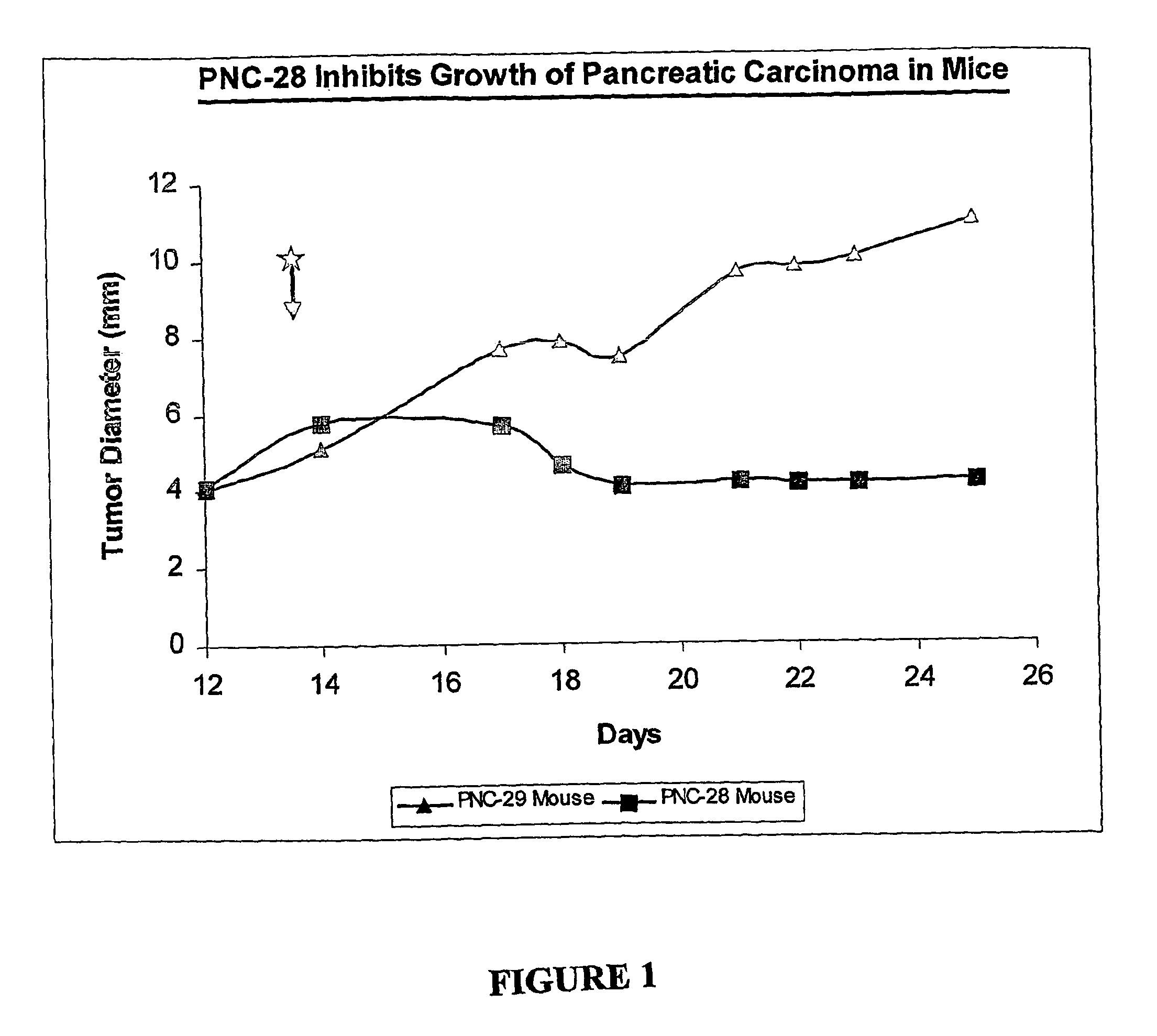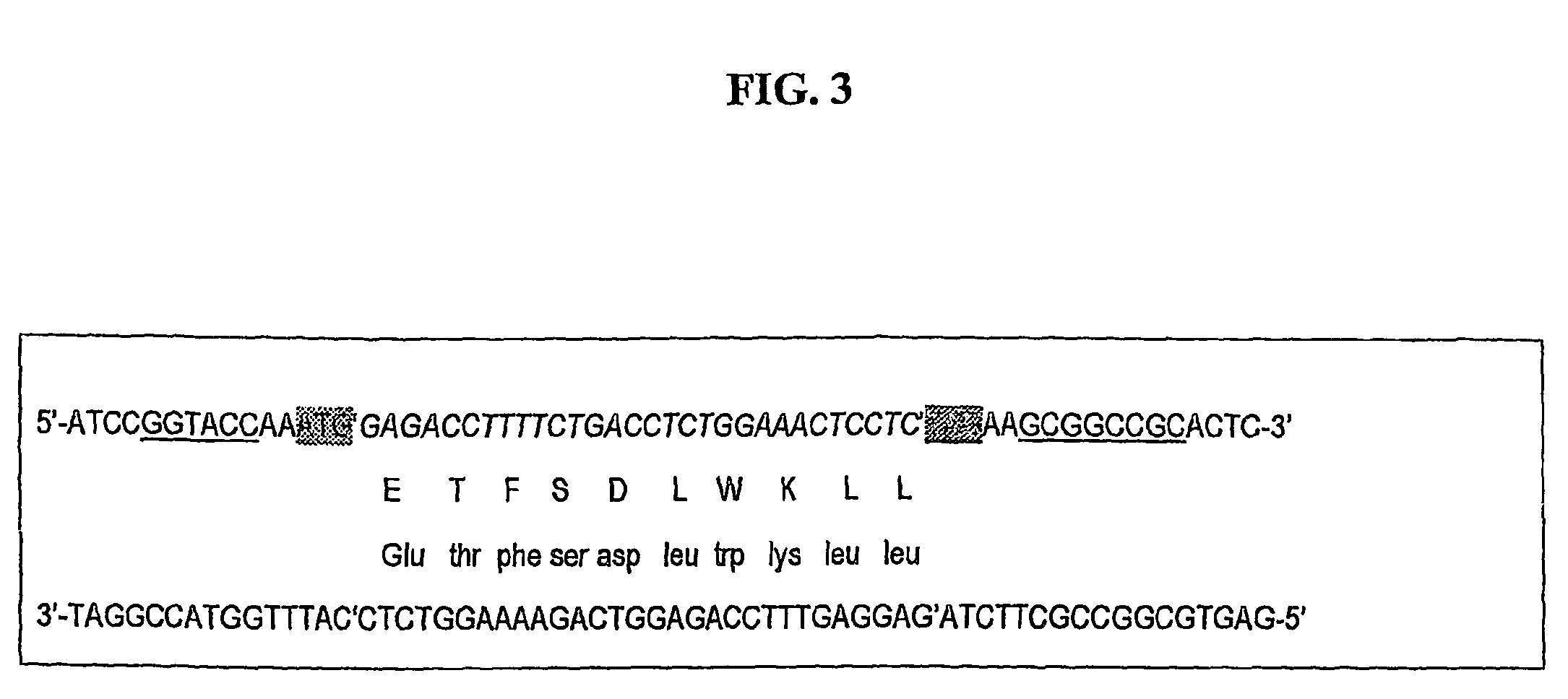Peptides selectively lethal to malignant and transformed mammalian cells
a technology of peptides and transformed mammalian cells, which is applied in the direction of peptide/protein ingredients, p53 protein, peptide sources, etc., can solve the problems of limiting the practical development of vectors, defective p53 gene can have numerous adverse consequences for the cell, and damage to the dna within the cells of these cells
- Summary
- Abstract
- Description
- Claims
- Application Information
AI Technical Summary
Benefits of technology
Problems solved by technology
Method used
Image
Examples
example i
[0076]The following experiment was performed to compare effectiveness of subject peptides having the leader sequence attached to the amino terminal end. As described supra, peptides synthesized with a leader sequence on the carboxyl terminal promoted α-helix formation in the peptide, which is the active conformation of the p53 part of this peptide when bound to MDM-2. As described supra, subject peptides having the amino acid sequences as set forth in SEQ ID NOs:1, 2, and 3 are strongly toxic to a wide variety of human cancer cells, including those that are homozygously p53 gene-deleted. An α-helix probability profile for each peptide having the sequences set forth in SEQ ID NOs:1-3 was performed using two different methods, one using helix probabilities from the protein database (Karplus, K. et al., (1998) Bioinformatics 14:846-856), and the other using the Ising model based on helix nucleation (σ) and growth (s), equilibrium constants determined experimentally from block copolymer...
example ii
[0081]Nu / Nu mice (Harlan Laboratories, Indianapolis, Ind., n=10) and weighing 20-22 g, were xenotransplanted subcutaneously (s.c.) with live pancreatic carcinoma cells BMRPA1. TUC-3 (1×106 cells / mouse) in the left hind region. Tumors were allowed to develop and grow and during daily examinations it was observed that all mice developed tumors with very similar growth rates.
[0082]After 12 days the tumors had reached sizes of 3 to 6 mm diameter and the mice were separated into two groups of 5 mice each. Each group was implanted s.c. with Alzet® osmotic pumps to deliver in a constant rate and over a defined period of 14 days a total volume of 0.095 ml volume of normal saline containing the respective peptide at a concentration of 20 mg / mouse. One group of mice received PNC-28 (the peptide having the amino acid set forth in SEQ ID NO:3) fused at its carboxy terminal end to the penetratin leader sequence (SEQ ID NO:4) and the other group of mice received PNC-29, a control peptide of simil...
example iii
[0084]Using the same methodology of Example II, pumps were started at the same time as live pancreatic carcinoma cells BMRPA1.TUC-3 (1×106 cells / mouse) were xenotransplanted into mice (n=10). Five mice were administered PNC28 and 5 mice were not treated at all (sham treated). Results are tabulated below.
[0085]
TABLE 47 Days14 Days21 DaysTreatmentTumor SizeSham treated4.8 ± 1.811.7 ± 2.314.8 ± 3.6PNC-28 treated 3 ± .63.1 ± .94.4 ± .8
PUM
| Property | Measurement | Unit |
|---|---|---|
| size | aaaaa | aaaaa |
| concentrations | aaaaa | aaaaa |
| concentrations | aaaaa | aaaaa |
Abstract
Description
Claims
Application Information
 Login to View More
Login to View More - R&D
- Intellectual Property
- Life Sciences
- Materials
- Tech Scout
- Unparalleled Data Quality
- Higher Quality Content
- 60% Fewer Hallucinations
Browse by: Latest US Patents, China's latest patents, Technical Efficacy Thesaurus, Application Domain, Technology Topic, Popular Technical Reports.
© 2025 PatSnap. All rights reserved.Legal|Privacy policy|Modern Slavery Act Transparency Statement|Sitemap|About US| Contact US: help@patsnap.com



